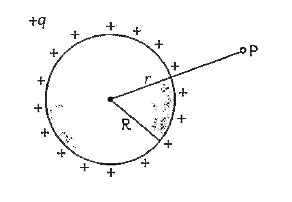Assuming only electrostatic forces are present, electric field lines in the space surrounding a charge distribution show
Only the directions in which static charges would accelerate when at points on those lines.
Only the directions in which moving charges would accelerate when at points on those lines.
Tangents to the directions in which either static charges or moving charges would accelerate when passing through points on those lines.
The paths static or moving charges would take.
The correct Answer is:C
To solve the question regarding the behavior of electric field lines in the space surrounding a charge distribution, we can follow these steps:
1. Understand Electric Field Lines: Electric field lines are visual representations of the electric field created by a charge distribution. They indicate the direction of the electric field at various points in space.
2. Direction of Electric Field Lines: The direction of the electric field lines is determined by the force experienced by a positive test charge placed in the field. The lines point away from positive charges and toward negative charges.
3. Tangent to Electric Field Lines: At any point on an electric field line, the direction of the electric field can be represented by a tangent to the line at that point. This tangent indicates the direction in which a positive test charge would accelerate if placed at that point.
4. Consider Static and Moving Charges: The question asks about the acceleration of charges. A static charge will accelerate in the direction of the electric field, while a moving charge will also experience a force due to the electric field, which can change its direction and speed.
5. Evaluate the Options:
- Option 1: "Only the direction in which static charges would accelerate" – This is incomplete because it ignores moving charges.
- Option 2: "Only the direction in which moving charges would accelerate" – This is also incomplete for the same reason.
- Option 3: "Tangent to the direction in which either the static charges or moving charges would accelerate when passing through the points on those lines" – This option correctly encompasses both static and moving charges.
6. Conclusion: The correct answer is Option 3, as it accurately describes the behavior of electric field lines concerning both static and moving charges.
Final Answer:
The electric field lines in the space surrounding a charge distribution show the tangent to the direction in which either static charges or moving charges would accelerate when passing through the points on those lines (Option 3).
- Option 1: "Only the direction in which static charges would accelerate" – This is incomplete because it ignores moving charges.
- Option 2: "Only the direction in which moving charges would accelerate" – This is also incomplete for the same reason.
- Option 3: "Tangent to the direction in which either the static charges or moving charges would accelerate when passing through the points on those lines" – This option correctly encompasses both static and moving charges.
The electric field lines in the space surrounding a charge distribution show the tangent to the direction in which either static charges or moving charges would accelerate when passing through the points on those lines (Option 3).
Topper's Solved these Questions
- BOOK - RESNICK AND HALLIDAYCHAPTER - ELECTRIC CHARGES AND FIELDSEXERCISE - Practice Questions (More than one correct Type )3videos
ELECTRIC CHARGES AND FIELDS
- BOOK - RESNICK AND HALLIDAYCHAPTER - ELECTRIC CHARGES AND FIELDSEXERCISE - Practice Questions (Linked Comprehension)5videos
ELECTRIC CHARGES AND FIELDS
- BOOK - RESNICK AND HALLIDAYCHAPTER - ELECTRIC CHARGES AND FIELDSEXERCISE - Problems63videos
ELECTRIC CHARGES AND FIELDS
- BOOK - RESNICK AND HALLIDAYCHAPTER - ELASTICITYEXERCISE - PRACTICE QUESTIONS (Integer Type)3videos
ELASTICITY
- BOOK - RESNICK AND HALLIDAYCHAPTER - ELECTRIC POTENTIALEXERCISE - (PRACTICE QUESTIONS) Integer Type1videos
ELECTRIC POTENTIAL
Similar Questions
Knowledge Check
- Question 1 - Select One
Electric field intensity at point P due to charge distributed over a sphere is:
 AE=14πε0qrBE=σR2ε0r2CE=14πε0qrDE=0
AE=14πε0qrBE=σR2ε0r2CE=14πε0qrDE=0 - Question 2 - Select One
The Gaussian surface for calculating the electric field due to a charge distribution is
Aany closed surface around the charge distributionBany surface near the charge distributionCa spherical surfaceDa closed surface at a every point of which electric field has a normal components which is zero or a fixed value - Question 3 - Select One
The Gaussian surface for calculating the electric field due to a charge distribution is
Aany surface near the charge distributionBalways a spherical surfaceCa symmetrical closed surface containing the charge distribution, at very point of which electric field has a single fixed valueDNone of the given options
Electrostatics | Electric Charge
View SolutionFind the direction of electric field at P for the charge distribution as shown infigure.
 View Solution
View SolutionTotal electric force on an electric dipole placed in an electric field of a point charge is :
View SolutionThe Gaussian surface needed for calculating the electric field due to a charge distribution is
View SolutionIf electric field is uniform, then the electric lines of forces are :
View Solution


